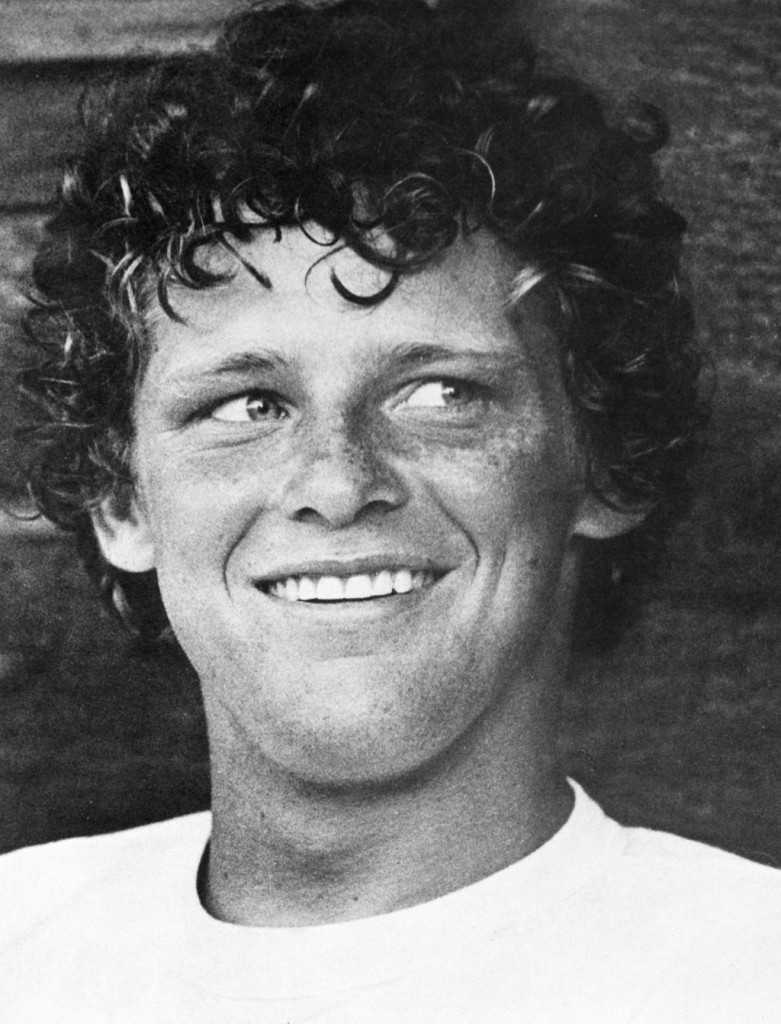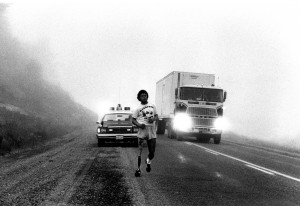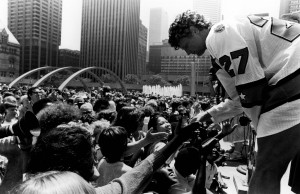Exhibiting a Canadian Legend

Terry Fox, a Canadian legend. Photo: Gail Harvey.
“You are a tremendous inspiration to me. You don’t know what you’ve done for me. Thank you.
— Terry Fox, to the people of Oshawa, July 9, 1980
Terry Fox is a Canadian legend known around the world. Thousands of people, both nationally and internationally, take part in annual Terry Fox runs — and have been doing so for 35 years now. To date, more than $650 million has been raised for cancer research, all in the name of this incredibly selfless and courageous young man who believed in miracles.
This may be on our minds every September, but once finish lines have been crossed, tears have dried and heart rates have returned to normal, Terry Fox and his Marathon of Hope pass back into legend to be re-enacted again in a year’s time. Life, for many, goes on.
For the past two years, however, the Marathon of Hope has been an integral part of my daily life. Since June 2013, I have been working as a research assistant on the Museum’s upcoming exhibition, Terry Fox – Running to the Heart of Canada, which will soon open at the Museum. Working on a subject that is so uniquely entrenched in the Canadian psyche has been both more challenging and more rewarding than I could have imagined.

Terry running through Ontario. Photo: Gail Harvey.
When I first arrived on the job, I was asked to review all available footage of the Marathon of Hope. Throughout that first summer, I spent hour after hour watching Terry run, give speeches and enjoy what little downtime he had. I held my breath as Terry related the story of almost being hit by a transport truck in Nova Scotia. I grinned as he performed the opening kickoff at an Ottawa–Saskatchewan football game. I laughed as he engaged his younger brother Darrell in a cake fight on his birthday. I grimaced when he lay on a stretcher and, through laboured breaths, told reporters in Thunder Bay that he had to go home for more treatment. And I cried when nurse Alison Sinson announced, in the early hours of June 28, 1981, that Terry had passed away peacefully — surrounded by those he loved. In short, I relived the Marathon of Hope daily from the comfort of my desk.

Terry greets supporters at a rally in Nathan Phillips Square in Toronto on July 11, 1980. Photo: Gail Harvey.
Having been born almost a decade after the Marathon of Hope ended, most of this was completely new to me. As I watched both the speeches and the candid footage over and over again, I began to piece together the Terry that kids don’t learn about in school. The Terry I was watching wasn’t a legend who could be easily depicted in a film, a book or even an exhibition. He was alternately funny and serious; charming and goofy; confident and shy; ecstatic and upset; energetic and exhausted. In short: he was a real person.
Watching the video footage raised a question: how can an exhibition possibly summarize the complexities of this young man? Should it even try? After all, he never wanted the attention to be on him as an individual — he said himself that “the only important part is that cancer can be beaten, and that the Marathon of Hope continues.”
The answer to this dilemma was surprisingly human as well: if a team of professionals, including this research assistant, could be brought to the heights and depths of emotion when going through the raw material, why not let those same materials do the talking? As historians and researchers, we can describe the gruelling trials that Terry faced with his primitive prosthesis until we’re blue in the face. Nothing, however, can compare to watching Terry huff and puff his way across the screen, or to being able to walk up to that same artificial leg, while trying to imagine running on it for 26 miles every day for 143 days.
I’ve now spent the better part of two years wading through videos, photographs, books, journals, letters, newspapers and artifacts in an attempt to get to the heart of what makes Terry Fox so legendary. It turns out that the title of the exhibition has it right: Terry Fox ran to the heart of Canada and into the hearts of Canadians, and this is why he will never be forgotten.

Terry in front of the Marathon of Hope van somewhere between Parry Sound and Estaire Ontario. Photo: Gail Harvey.
For the 35th anniversary of the Marathon of Hope, the Canadian Museum of History is offering visitors a chance to spend some time reliving this national phenomenon. I’m proud to say that I’ve had a small part in the efforts of the wonderful team who put this exhibition together. What are museums for, after all, if not to allow people to immerse themselves in our incredible history?
The exhibition preparations are almost over, but I don’t think any of us will ever truly leave Terry Fox behind. So, thank you, Terry. You were, and are, a tremendous inspiration, and you don’t know what you’ve done for us.